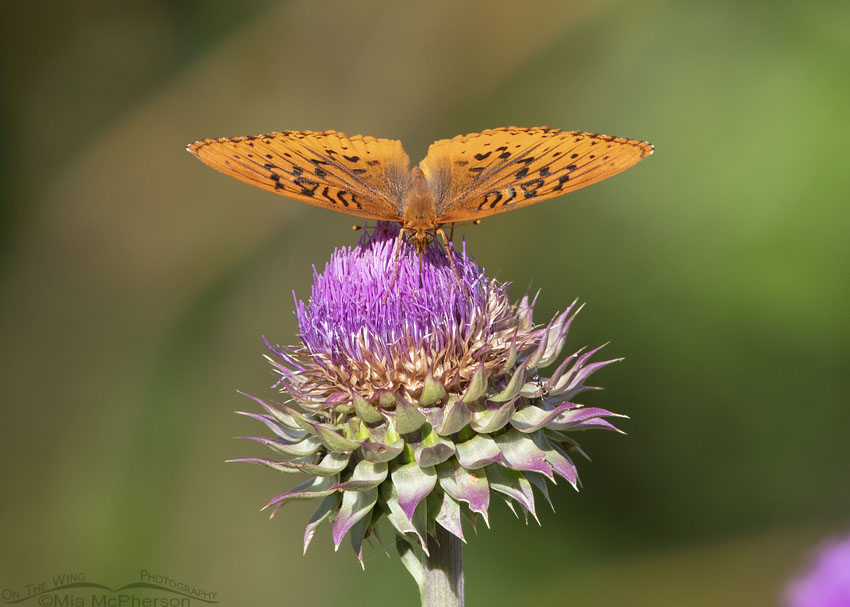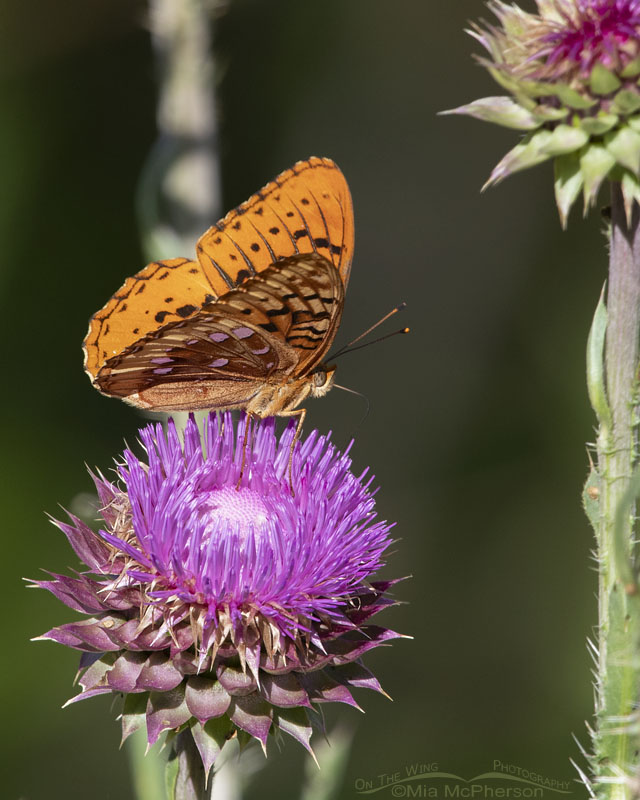People say that bird identification is hard and it can be. I do well with most bird identifications but I’m here to tell you that butterfly identification is much more of a challenge for me when it comes to some species such as fritillary butterflies.
 Fritillary butterfly on a Musk Thistle – Nikon D500, f7.1, 1/640, ISO 500, Nikkor 500mm VR with 1.4x TC, natural light
Fritillary butterfly on a Musk Thistle – Nikon D500, f7.1, 1/640, ISO 500, Nikkor 500mm VR with 1.4x TC, natural light
Yesterday while I was up in the Wasatch Mountains I spotted a fritillary butterfly on a Musk thistle and took some images of it as it nectared on the thistle. My brain immediately said “Fritillary” and for that moment that was, for me, a sufficient ID because I figured that later on I’d be able to narrow down the identification of the species.
Ha.
At first I was convinced that this butterfly was a Great Spangled Fritillary but after finding out how many species of fritillary butterflies can be found in Utah I became less confident of my butterfly identification skills. Male and female fritillary butterflies look different from each other and although those differences can be subtle that makes it even more of a challenge. I have a huge book called “The Dictionary of Butterflies and Moths” by Allan Watson and Paul E.S. Whalley and honestly going through it just confused me more. I also looked in my copy of “National Geographic Illustrated Guide to Wildlife” and no joy, I couldn’t pin down the ID. Looking on line wasn’t much help either because there can be so many misidentifications shared on the web.
 Fritillary butterfly – Nikon D500, f7.1, 1/800, ISO 500, -0.3 EV, Nikkor 500mm VR with 1.4x TC, natural light
Fritillary butterfly – Nikon D500, f7.1, 1/800, ISO 500, -0.3 EV, Nikkor 500mm VR with 1.4x TC, natural light
So, I’m going to ask for help later on today from bugguide.net with the identification of this fritillary butterfly. I don’t normally have to ask for identification assistance but I need it for this other thing with wings. Bird ID is much easier for me.
If I get the ID sorted out I will update this post.
Life is good.
Mia
Click here to see more of my flower, shrub and tree photos. Click here to see more of my insect and spider images.
P.S., the spots under the wings of the butterfly aren’t pink, they are just picking up the pink from the thistle, they are actually more of a silvery white than is seen in this bottom image.
These are fritillary butterflies that can be found in Utah:
Agraulis vanillae incarnata (gulf fritillary)
Euptoieta claudia (variegated fritillary)
Speyeria cybele letona (letona fritillary)
Speyeria cybele charlotti (great spangled fritillary)
Speyeria aphrodite ethne (aphrodite fritillary)
Speyeria nokomis nokomis (nokomis fritillary)
Speyeria nokomis apacheana (nokomis fritillary)
Speyeria edwardsi (Edwards fritillary)
Speyeria coronis snyderi (coronis fritillary)
Speyeria zerene platina (zerene fritillary)
Speyeria callippe harmonia (callippe fritillary)
Speyeria egleis utahensis (great basin fritillary)
Speyeria egleis linda (great basin fritillary)
Speyeria hesperis wasatchia (northwestern fritillary)
Speyeria hesperis chitone (northwestern fritillary)
Speyeria hydaspe sakantula (hydaspe fritillary)
Speyeria mormonia mormonia (mormon fritillary)
Speyeria mormonia eurynome (mormon fritillary)
Boloria selene tollandensis (silver-bordered fritillary)
Boloria kriemhild kriemhild (relict fritillary)
Boloria freija browni (freija fritillary)
Boloria chariclea helena (arctic fritillary)


Absolutely perfect!!!!
We are so in love with your photography!
Thank you for sharing!
Reminds me of some wonderful times ‘Splorin
Beautiful thing – regardless of its name.
You are so right! Beautiful things don’t have to have names…they just have to BE…besides, names can vary from place to place, people to people…they are artificial tags we stick on things. Not real in themselves…this is something beautiful to look at…that all that matters…and, as usual, Mia captured it for us to see and study… But
Reviewed some of the fritillary butterflies you listed as found in Utah. Looks most like male Northwestern fritillary. Love the matchstick looking antennae . I’m not a bug expert. Great spangled markings are more distinctive than this one. Good luck with ID. K
Wow! Gorgeous shots! I especially like the second one — regardless of the name. 😉
Nice photos, I have these in my yard from time to time and I have given up with IDing them!
Mia’s Magic!!! Is there more to say???
Beautiful photos, Mia.
Beautiful photos & beautiful butterfly. How cool is that for the spots under the wings to pick up the colour of the thistle. Nature is so fascinating.
Great photos of this little one! I agree about their ID…I’ve spent a few days sometimes on these little ones. It’s always a feeling of accomplishment when you can nail it down though.